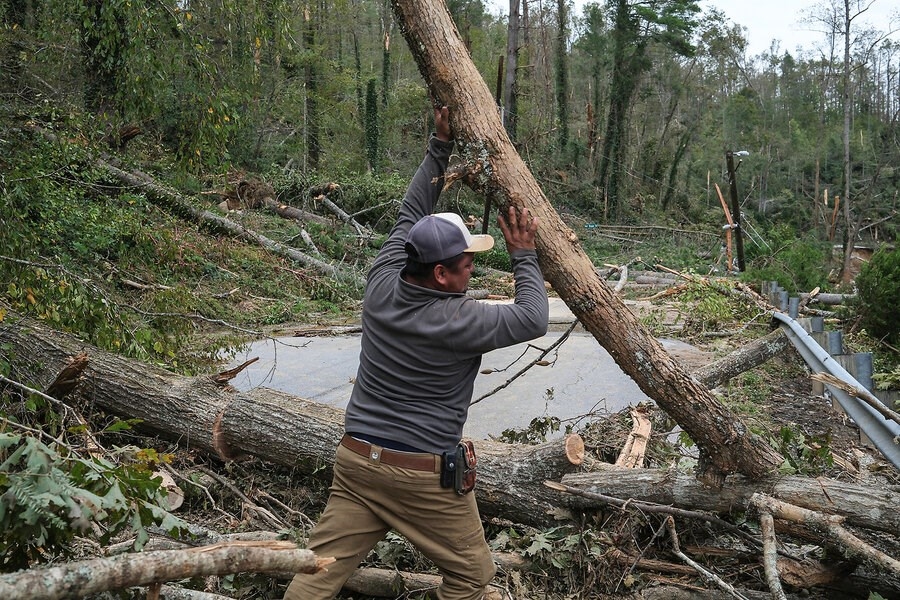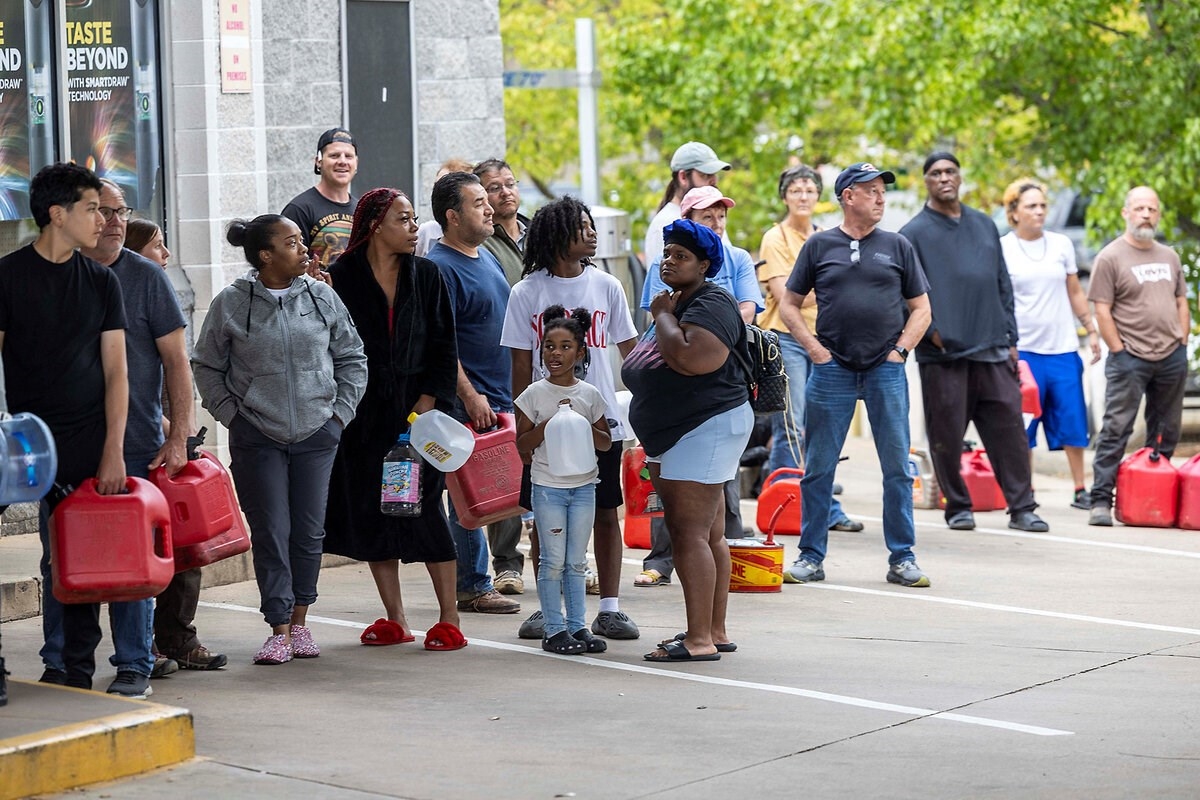REPRINTED WITH PERMISSION FROM THE CHRISTIAN SCIENCE MONITOR
Locals in western North Carolina, where rescue efforts are impeded by terrain and a thinly dispersed population, are assisting each other in the aftermath of Hurricane Helene – and preparing for years of recovery.
 A volunteer helps to clean up U.S. Route 64 between Chimney Rock and Bat Cave, North Carolina, Sept. 30, 2024. Marco Bello/Reuters
A volunteer helps to clean up U.S. Route 64 between Chimney Rock and Bat Cave, North Carolina, Sept. 30, 2024. Marco Bello/Reuters
|Henderson County, N.C.
During 12 years as a National Guard member in New York, Tom Ford worked on relief missions to hurricane-hit communities, including when Sandy pummeled the New York area in 2012.
But he’s never seen anything as bad as the impact of Hurricane Helene on his rural Appalachian community here in western North Carolina.
On Monday, Mr. Ford stood in an empty parking lot in Hendersonville, the county seat, where he came to meet his father-in-law, Matt Karkos. Mr. Karkos had no power or water at his house, on which a tree had fallen, and many roads were impassable. He had decided to drive to South Carolina to stay with his brother. Mr. Ford had brought a can of gas from his generator supply to top off the tank.
“You saved us,” Mr. Karkos told him. “I didn’t know if we were going to make it.”
Across this region, rescuers are still searching for missing people, and at least 125 are dead across the six states that took the brunt of the hurricane. Residents who made it through the storm have grown frustrated as they wait for power, water, cell services, and food, even as state and federal officials pour supplies into affected areas, including Asheville, the largest population center in the region.
Officials in Asheville, where a river burst its banks and inundated low-lying neighborhoods, have compared the city’s destruction to Hurricane Katrina, which submerged much of New Orleans in 2005.
While the physical and human toll now is likely to be lower, the mountainous terrain and dispersed population make the response to Helene tough to manage and could slow the transition to a recovery phase, after power and other services are restored. Water systems in Asheville could take weeks to restore; residents are depending on trucked potable water.
“It’s going to take years,” says Mr. Ford, noting that Katrina’s impact is still apparent.
 Travis Long/ The News & Observer/ReutersAsheville residents line up for gasoline at a gas station Sept. 29, 2024. The remnants of Hurricane Helene caused widespread flooding, downed trees, and power outages in western North Carolina.
Travis Long/ The News & Observer/ReutersAsheville residents line up for gasoline at a gas station Sept. 29, 2024. The remnants of Hurricane Helene caused widespread flooding, downed trees, and power outages in western North Carolina.After the storm passed, Mr. Ford joined his neighbors in clearing debris from back roads, using chain saws and trucks. Almost everyone in Henderson can share stories of pitching in to help, ferrying food to stranded neighbors and removing tree limbs strewn around.
But rescuers are struggling to reach cutoff communities, including vacation homes by Lake Lure, once an idyllic draw for visitors, now a swamp of splintered trunks, boats, and docks.
The logistics of delivering aid along roads flooded or choked with trees and debris has slowed their efforts in some of the hardest-hit communities. Some survivors have been rescued by boat or helicopter, but many others are still unaccounted for. National Guard units from North Carolina and other states are working with local responders in the area.
“The devastation was beyond belief,” North Carolina Gov. Roy Cooper said at a news conference Monday. “And even when you prepare for something like this, this is something that’s never happened before in western North Carolina.”
Asheville has been hit by storms before, but rarely: A flood in 1916 swelled the French Broad River to 21 feet above its normal level, and 80 people died in the resulting floods. Last Friday, the river peaked at more than 24 feet, making it the worst in over a century.
In the aftermath, gas, food, and water are scarce. After assisting his father-in-law, Mr. Ford got back in his car with his wife and two young girls. The few grocery stores open had long lines and only accepted cash. But the family had enough food at home.
Around the corner, Shunneisha Allen was lined up with dozens of other vehicles outside a food distribution center run by a faith-based nonprofit. She had driven home early last Thursday from the hospital where she works, not knowing it would be days before she’d leave again. Power had just been restored to her apartment building. Now she needed food and drinking water.
Growing up in Greensboro, she knew how hurricane winds could tear up buildings. But this region of the state wasn’t at risk, or so she thought. “The mountains used to be safe,” she says.
Her parents live in Chimney Rock, by Lake Lure. When she couldn’t contact them last Friday – no cell service – her sister decided to drive there, but didn’t reach their home. Ms. Allen shows a cellphone video of her sister by her abandoned car, brown water swirling around her waist. “I said, ‘Good thing you can swim,’” Ms. Allen laughs. Her parents were later rescued by the fire department.
 Simon Montlake/The Christian Science MonitorElizabeth Willson Moss hands a care package to Jamie Wiener at a food distribution center in Hendersonville, North Carolina, Sept 30, 2024. Ms. Willson Moss is the executive director of Interfaith Assistance Ministry, a nonprofit, which began handing out food on Sept. 30 to residents in the aftermath of Hurricane Helene.
Simon Montlake/The Christian Science MonitorElizabeth Willson Moss hands a care package to Jamie Wiener at a food distribution center in Hendersonville, North Carolina, Sept 30, 2024. Ms. Willson Moss is the executive director of Interfaith Assistance Ministry, a nonprofit, which began handing out food on Sept. 30 to residents in the aftermath of Hurricane Helene.
At the food pantry, Elizabeth Willson Moss was preparing volunteers in the driveway beside stacks of boxes of canned food and bags of apples and celery. Her organization, Interfaith Assistance Ministry, regularly feeds families and had stocks on hand at its warehouse for this first day of Helene handouts. More will be needed to keep the operation going, and she’s waiting on requests to state and federal agencies that are bringing in supplies.
“They’re still in search-and-rescue mode. On our end, we know we can help,” she says. “We’re using every bit of food that we have.”
Like many families cut off by storm damage but otherwise safe, Kayla Hertzfeld, who lives in Ashe County, had enough food for the first few days. “Our kids are surviving on peanut butter and jelly sandwiches,” she says. By Monday, though, she decided to leave town with her two young children, joining a crush of cars headed out, while her husband stayed behind to help out.
Ms. Hertzfeld knows neighbors whose homes are uninhabitable. Then there are families that nobody has reached, including those she works with as a speech pathology assistant. “It’s bad. Real bad,” she says.
Seeing the scale of destruction makes her wonder how rural communities like hers, sprinkled across rugged mountains, can rebuild what has been lost. But she’s encouraged by what her husband and others are doing to clear roads and act as first responders to trapped families.
“We come together as a community to support each other,” she says. “It’s one of those communities. That’s going to be the biggest help to get us back on our feet.”
Editor's note: The spelling of Kayla Hertzfeld's name and her job title, speech pathology assistant, were corrected on Oct. 1, 2024, the day of initial publication for this article.
Page created on 10/2/2024 4:29:38 PM
Last edited 10/2/2024 4:39:09 PM
